Rules > Rule Book
Link zur deutschen Version.
Introduction
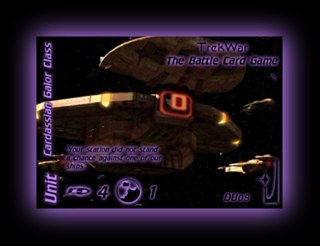 You
will find more annotations and a lot of examples in the Complete
Guide and the Tutorial. This is meant
to be a streamlined text for reference.
You
will find more annotations and a lot of examples in the Complete
Guide and the Tutorial. This is meant
to be a streamlined text for reference.
Prepare for Battle
At the moment "TrekWar - The Battle Card Game" (BCG) is a two-player only game. Each player will command a set of 30 cards. These so called Decks play differently.
 -
Federation (blue): The Federation has mighty allies and controls the Space
Station called "Deep Space Nine", which is the strongest Unit
in the Game.
-
Federation (blue): The Federation has mighty allies and controls the Space
Station called "Deep Space Nine", which is the strongest Unit
in the Game.
![]() -
Dominion (violett): The Dominion has the ability to quickly create reinforcements.
Moreover, Dominion technology is more advanced than the Federation's.
-
Dominion (violett): The Dominion has the ability to quickly create reinforcements.
Moreover, Dominion technology is more advanced than the Federation's.
Getting Ready
- Each Player has to shuffle his/her Deck. Build a card pile (face down) for each side.
Arrange the playing materials like this:
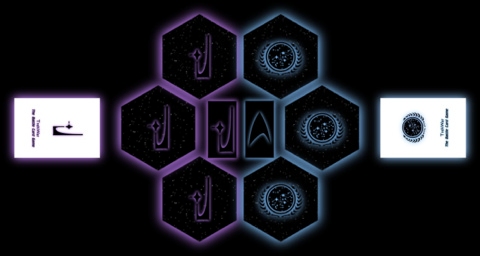
- place six hexagons (Sectors) in a circle, three in the colour of the Federation and three in the colour of the Dominion player.
- the central Sector is the first battleground. Its colour will be decided after the first skirmish. Therefore place the two indicators (Fleets) there.
- each player puts his Deck pile in front of her/his Sectors.
The Goal of The Game
The players are to take control of all Sectors. This they accomplish by fighting for each territory with their forces represented by their Decks.
The Structure of the Battle
The game is divided into single Fights. In order to seize a Sector from the other Player, one has to win a Fight for that territory. The first Fight is for the central Sector. After that, the Player who has lost the last Fight decides for what Sectors he wants to fight next. Therefore he places his Fleet in the Sector from which he wants to attack (there must be a neighbouring enemy Sector). Then he picks a neighbouring enemy Sector he wants to seize. There the other Player places her/his Fleet.
If the attacking player wins the Fight, then she/he seizes the Sector where the enemy Fleet is located. If the attacking player looses the Fight, then the defending Player seizes the Sector from which the enemy Fleet attacked.
The game ends when:
- One player occupies all Sectors. Then she/he has won the Battle.
- A Battle ends with one player who has depleated her/his Deck pile. Then the Player who controls more Sectors than the other wins the Battle.
About the Cards:
There are four different types of Cards. Most of them share common features. So there is not much to learn before starting to play.
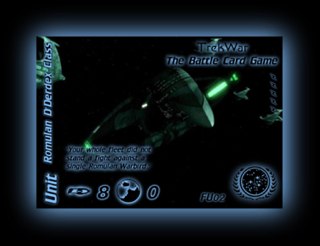 -
Units: These are the most common Cards in the game. They represent the
ships, troops and installations of the two Fleets. One Unit must be played
each Turn.
-
Units: These are the most common Cards in the game. They represent the
ships, troops and installations of the two Fleets. One Unit must be played
each Turn.
![]() One can identify a Unit by the title "Unit".
One can identify a Unit by the title "Unit".
![]() The Name of the Unit identifies it. This sounds trivial, but the exact
name of a Unit will become important in later editions and additions of
and to the BCG.
The Name of the Unit identifies it. This sounds trivial, but the exact
name of a Unit will become important in later editions and additions of
and to the BCG.
![]() A short text next to the Cards name can be a very important thing to pay
attention to. If the Text is black againt a lit background (like in the
picture above) it is just a quote or description. These black texts can
be ignored, their only purpose is to add depth to the atmosphere of the
Game.
A short text next to the Cards name can be a very important thing to pay
attention to. If the Text is black againt a lit background (like in the
picture above) it is just a quote or description. These black texts can
be ignored, their only purpose is to add depth to the atmosphere of the
Game.
 Bright texts against a darker background (Special Effects) are a totaly
different thing. The text usually affects the rules of the game. It either
allowes special actions which are not granted by these rules or it disposes
some regulations which usually apply. Special Effects have a higher priority
than the text of these Rules your reading at the moment.
Bright texts against a darker background (Special Effects) are a totaly
different thing. The text usually affects the rules of the game. It either
allowes special actions which are not granted by these rules or it disposes
some regulations which usually apply. Special Effects have a higher priority
than the text of these Rules your reading at the moment.
![]() At the bottom of each Card you will find two symbols with two digits.
The starship and the left number represent the Units Force in Space, the
planet and right number represent the Units Force on a planets Surface.
At the bottom of each Card you will find two symbols with two digits.
The starship and the left number represent the Units Force in Space, the
planet and right number represent the Units Force on a planets Surface.
 The cryptic string is a short identifier for each Card. This way you can
refer to a specific Card with just four digits.
The cryptic string is a short identifier for each Card. This way you can
refer to a specific Card with just four digits.
The Fleet emblem is for quick reference only (especially for players who are colour blind).
![]() There are also
a number of bolts on most Cards. These can be ignored at the moment. In
later additions of the game these will make Deck building possible.
There are also
a number of bolts on most Cards. These can be ignored at the moment. In
later additions of the game these will make Deck building possible.
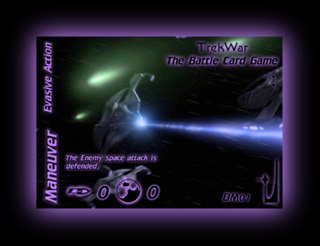 -
Maneuvers: These Cards represent the special moves a Unit can perform.
They are always played in addition to a Unit and boost its Forces and/or
add Special Effects. A Maneuver causes a tactical advantage that lasts
just one turn.
-
Maneuvers: These Cards represent the special moves a Unit can perform.
They are always played in addition to a Unit and boost its Forces and/or
add Special Effects. A Maneuver causes a tactical advantage that lasts
just one turn.
- Commands: These Cards represent the strategic aspects of Battle, e.g. leadership or technological advantages. Like Maneuvers, Commands can add Force and Special Effects to Units. But in difference Commands have long lasting effects for a whole Fight.
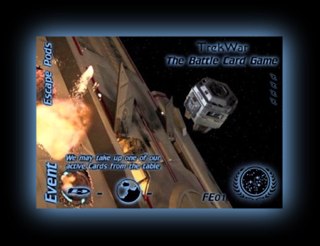 -
Events: These Cards represent the strategic moves that are typically for
the Player's race. Events cause global changes in the Game, which do not
only affect the fighting Units.
-
Events: These Cards represent the strategic moves that are typically for
the Player's race. Events cause global changes in the Game, which do not
only affect the fighting Units.
Like Maneuvers, Events grant certain tactical advantages for just one turn but cause no direct boost of a Unit's abilities. An Event's Special Effect more likely gives a player more options to make her/his next turn, than supporting a Unit's fighting capabilities.
About the Table:
The Board is just one part of the complete set up of all playing materials (Table). The Cards are also arranged in a special way. This layout makes sure that all important information is clearly visible to both players. A complete Table in Game should look like this:
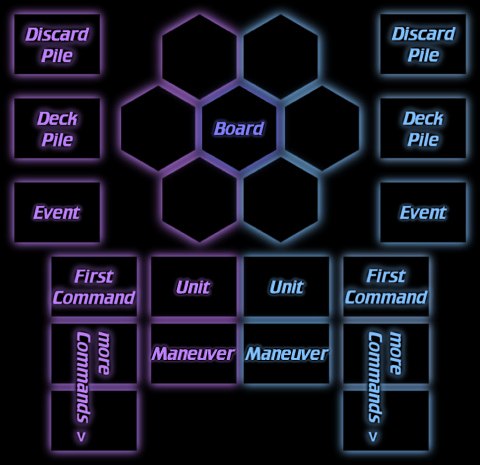
All Player's Cards in the bottom half (Units, Maneuvers, Commands) are refered to as Combating Forces.
Just Cards laying on top and facing up are considered active. The Discard Pile is an exception: No discarded Card can be an active Card.
Note: The Discard Pile is the place, where Cards are placed which usually can not be played again in the Game. Please differentiate between "dropping" and "discarding" a Card. If a Card is discarded, it means that the Card must be placed on top of the Discard Pile. Cards which are dropped usually are dealt with imediately (e.g. shuffled into the Deck Pile) and remain in the Game.
Fighting for a Sector:
When a fight for a Sector begins, both Players take up Cards from their Deck Pile until they have six Cards on their hand (Hand).
After that, each Player may decide to drop up to three Cards from her/his Hand in order to take up the same number of new Cards from his/her Deck Pile. The dropped Cards are shuffled with the rest of the Deck Pile.
Now the attacking player opens the Fight by playing one Card "Unit" and calling the Battleground (Space or Surface). Usually the Battleground will not change for the rest of the Fight. After that she/he may take up Cards from her/his Deck Pile as long as she/he has less than six Card on her/his Hand.
Note: In the first Fight there is no attacking Player. It is suggestet, that the older player opens the Fight. In a series of games the Player who won the last game opens the first Fight of the new Battle.
A Unit is placed face up next to the Board on the Players side of the table.
This is where the defending player begins the first Turn of the Fight.
A Turn consists of different phases (Stages) which are to be played in the following order. If a player uses actions allowed only in a certain Stage, she/he may not longer perform actions from previous Stages in that Turn.
1. Initial Stage: Some Special Effects and Symbols refer to this Stage. Other than that the Player turns her/his last Maneuvers and Events upside down (in order to indicate that they are no longer active).
2. Event Stage: At the beginning of her/his turn a Player may call an Event by playing an Event Card next to his Deck Pile.
3. Surrender Stage: Sooner or later a player will be forced to surrender, because she/he can or want not longer continue the Fight (that means he/she can or wants not meet the requirements to play the Deployment Stage). If a Player chooses to surrender the Sector, he terminates and looses the Fight.
4. Deployment Stage: A player must either perform actions from this Stage or surrender. The player must not perform the Deployment Stage, if she/he can not meet all requirements.
Allowed actions (see "About The Cards" and "About The Table"for details):
- Playing one Unit ON TOP of the last one (replacing it)
- Playing one Maneuver (ON TOP of the last Maneuver) or Command (NEXT to the last Command)
Requirements:
- Playing one Unit
- at the end of the Turn the Player's active Combating Forces (Unit, Maneuver, Commands) must match the Enemy's Attack.
To "match" the Enemy Attack means, that the Player's active Combating Forces must represent at least the same Force than the other Player's active Combating Force in the current Battleground (Space or Surface).
5. Last Stage: Some Special Effects refer to the Last Stage. The Player must name the total of his active Combating Force in the current Battleground and the name of the Battleground (e.g. "10 Space" or "7 Surface"). After that she/he may take up Cards from the Deck Pile as long as she/he has less than six Cards on her/his Hand.
Now the other Player may begin her/his Turn and perform actions from the Stages. This has to be repeated until one of the two Players surrenders.
After the Fight, all Cards played as Combating Forces (Units, Maneuvers, Commands) are removed from the Table and discarded. The Player who has won the Battle seizes the Enemy Sector he attacked. After the first Battle the central Sector is put into the Board with the winning side facing up.
Special Symbols:
There are two special Symbols on some Cards:
![]() "Take
Up": These Cards may be taken up from the Table at the Initial Stage,
if they are not discarded and the Enemy Player has no active Card with
the same symbol.
"Take
Up": These Cards may be taken up from the Table at the Initial Stage,
if they are not discarded and the Enemy Player has no active Card with
the same symbol.
![]() "Limited
Action": These Cards may not be played with any other Card in the
Stage. If a "Limited Action" is performed in a Stage, it is
the only action to be performed then.
"Limited
Action": These Cards may not be played with any other Card in the
Stage. If a "Limited Action" is performed in a Stage, it is
the only action to be performed then.
The End.
Comments, suggestions, questions at: The TrekWar-Staff